FORD MUSTANG 2000 4.G Owners Manual
Manufacturer: FORD, Model Year: 2000, Model line: MUSTANG, Model: FORD MUSTANG 2000 4.GPages: 224, PDF Size: 1.86 MB
Page 141 of 224
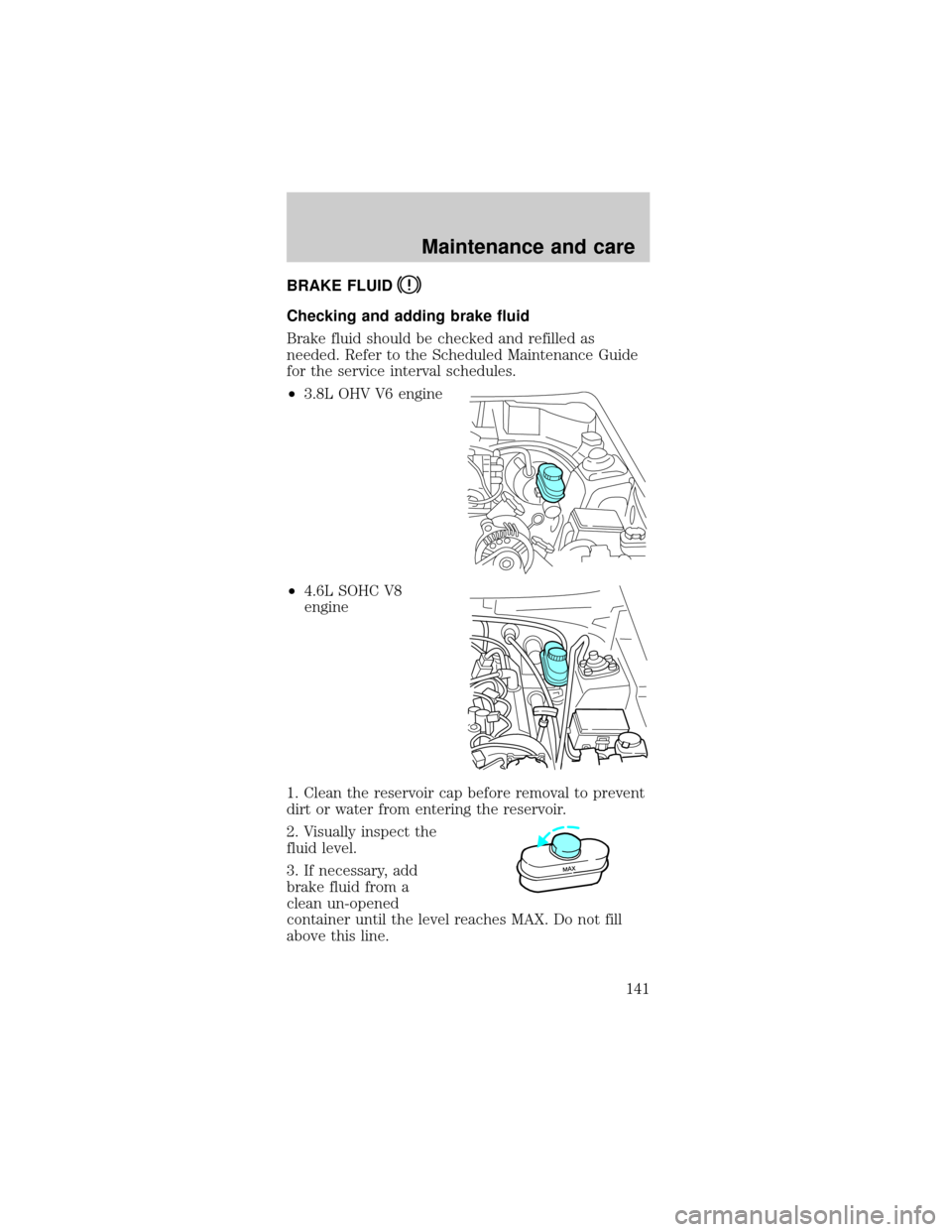
BRAKE FLUID
Checking and adding brake fluid
Brake fluid should be checked and refilled as
needed. Refer to the Scheduled Maintenance Guide
for the service interval schedules.
²3.8L OHV V6 engine
²4.6L SOHC V8
engine
1. Clean the reservoir cap before removal to prevent
dirt or water from entering the reservoir.
2. Visually inspect the
fluid level.
3. If necessary, add
brake fluid from a
clean un-opened
container until the level reaches MAX. Do not fill
above this line.
MAX
Maintenance and care
141
Page 142 of 224
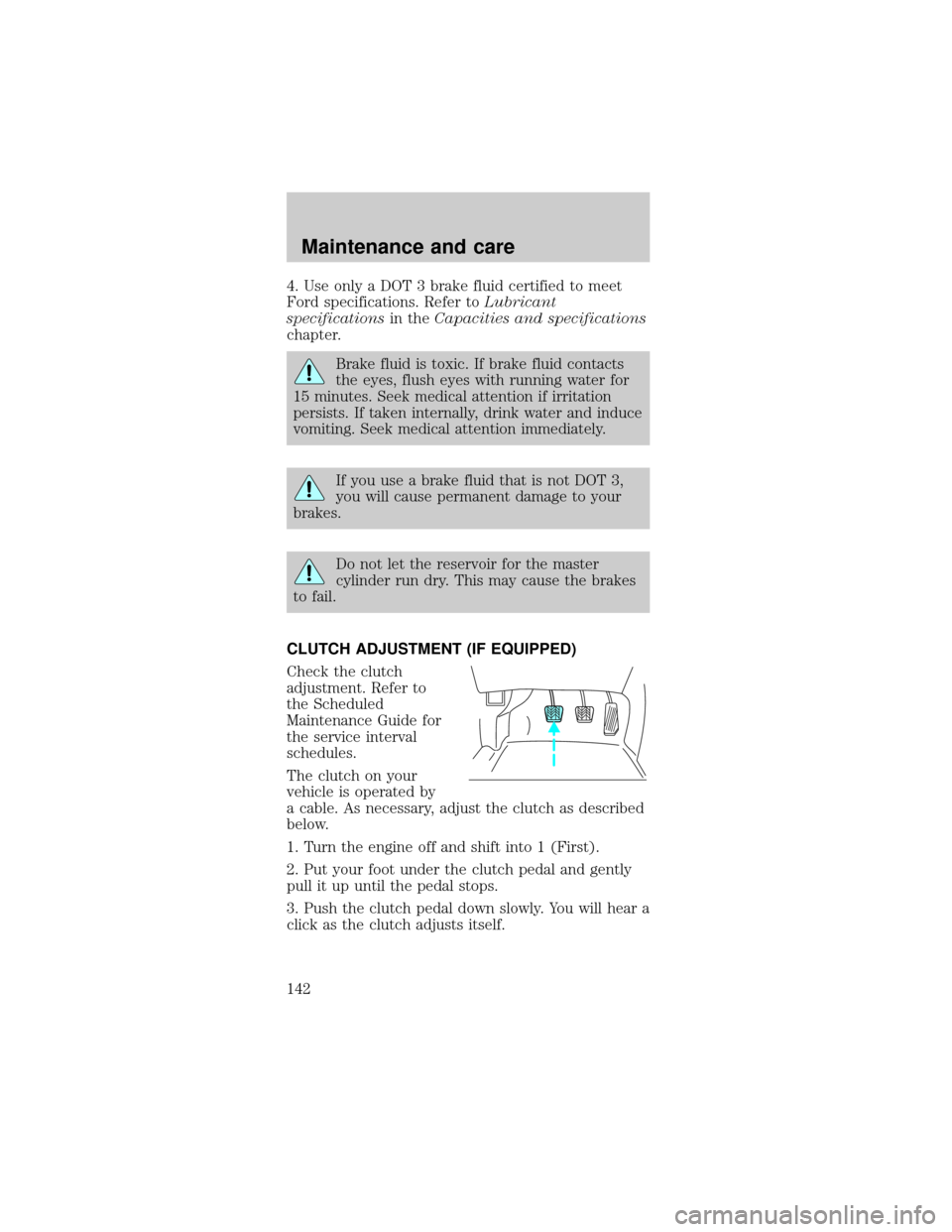
4. Use only a DOT 3 brake fluid certified to meet
Ford specifications. Refer toLubricant
specificationsin theCapacities and specifications
chapter.
Brake fluid is toxic. If brake fluid contacts
the eyes, flush eyes with running water for
15 minutes. Seek medical attention if irritation
persists. If taken internally, drink water and induce
vomiting. Seek medical attention immediately.
If you use a brake fluid that is not DOT 3,
you will cause permanent damage to your
brakes.
Do not let the reservoir for the master
cylinder run dry. This may cause the brakes
to fail.
CLUTCH ADJUSTMENT (IF EQUIPPED)
Check the clutch
adjustment. Refer to
the Scheduled
Maintenance Guide for
the service interval
schedules.
The clutch on your
vehicle is operated by
a cable. As necessary, adjust the clutch as described
below.
1. Turn the engine off and shift into 1 (First).
2. Put your foot under the clutch pedal and gently
pull it up until the pedal stops.
3. Push the clutch pedal down slowly. You will hear a
click as the clutch adjusts itself.
Maintenance and care
142
Page 143 of 224
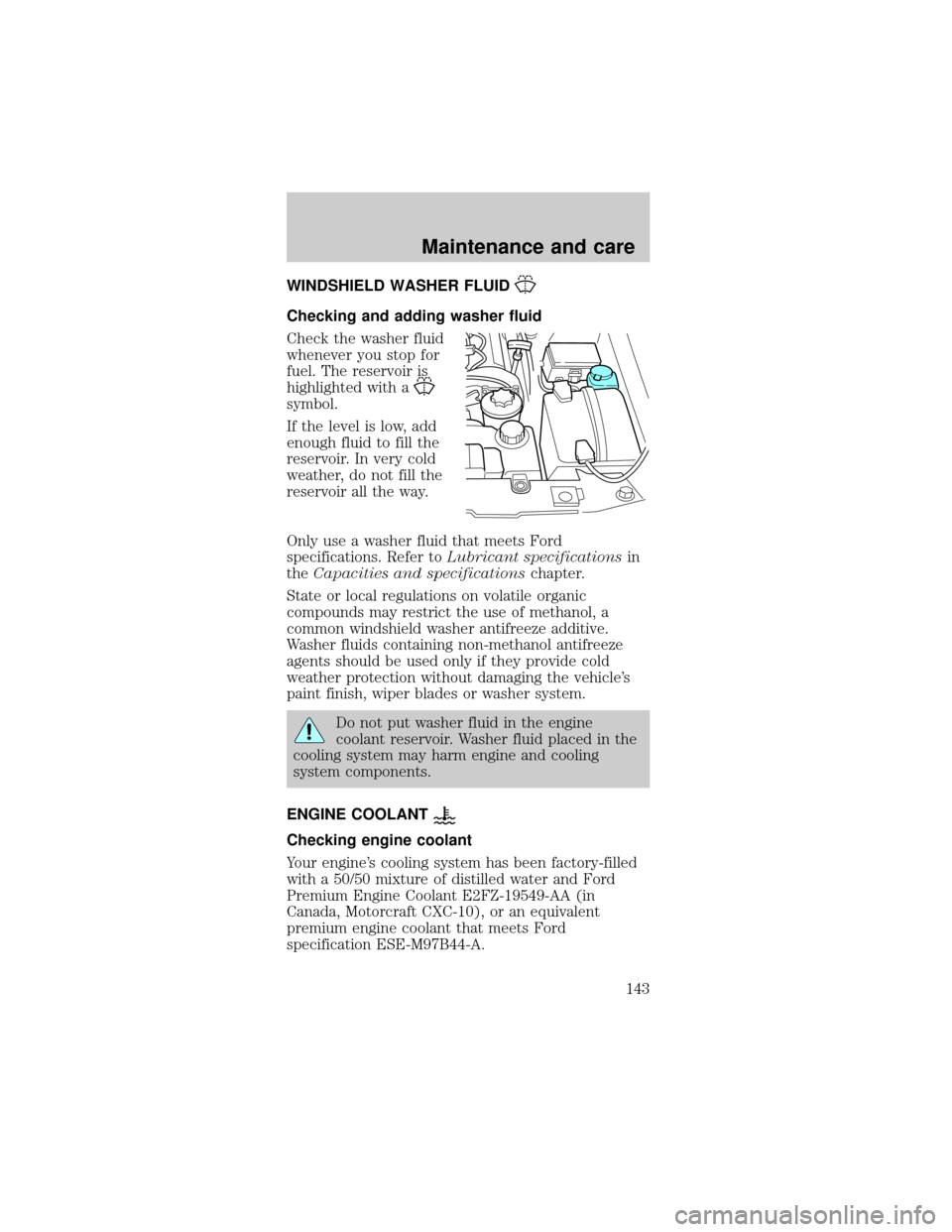
WINDSHIELD WASHER FLUID
Checking and adding washer fluid
Check the washer fluid
whenever you stop for
fuel. The reservoir is
highlighted with a
symbol.
If the level is low, add
enough fluid to fill the
reservoir. In very cold
weather, do not fill the
reservoir all the way.
Only use a washer fluid that meets Ford
specifications. Refer toLubricant specificationsin
theCapacities and specificationschapter.
State or local regulations on volatile organic
compounds may restrict the use of methanol, a
common windshield washer antifreeze additive.
Washer fluids containing non-methanol antifreeze
agents should be used only if they provide cold
weather protection without damaging the vehicle's
paint finish, wiper blades or washer system.
Do not put washer fluid in the engine
coolant reservoir. Washer fluid placed in the
cooling system may harm engine and cooling
system components.
ENGINE COOLANT
Checking engine coolant
Your engine's cooling system has been factory-filled
with a 50/50 mixture of distilled water and Ford
Premium Engine Coolant E2FZ-19549-AA (in
Canada, Motorcraft CXC-10), or an equivalent
premium engine coolant that meets Ford
specification ESE-M97B44-A.
Maintenance and care
143
Page 144 of 224
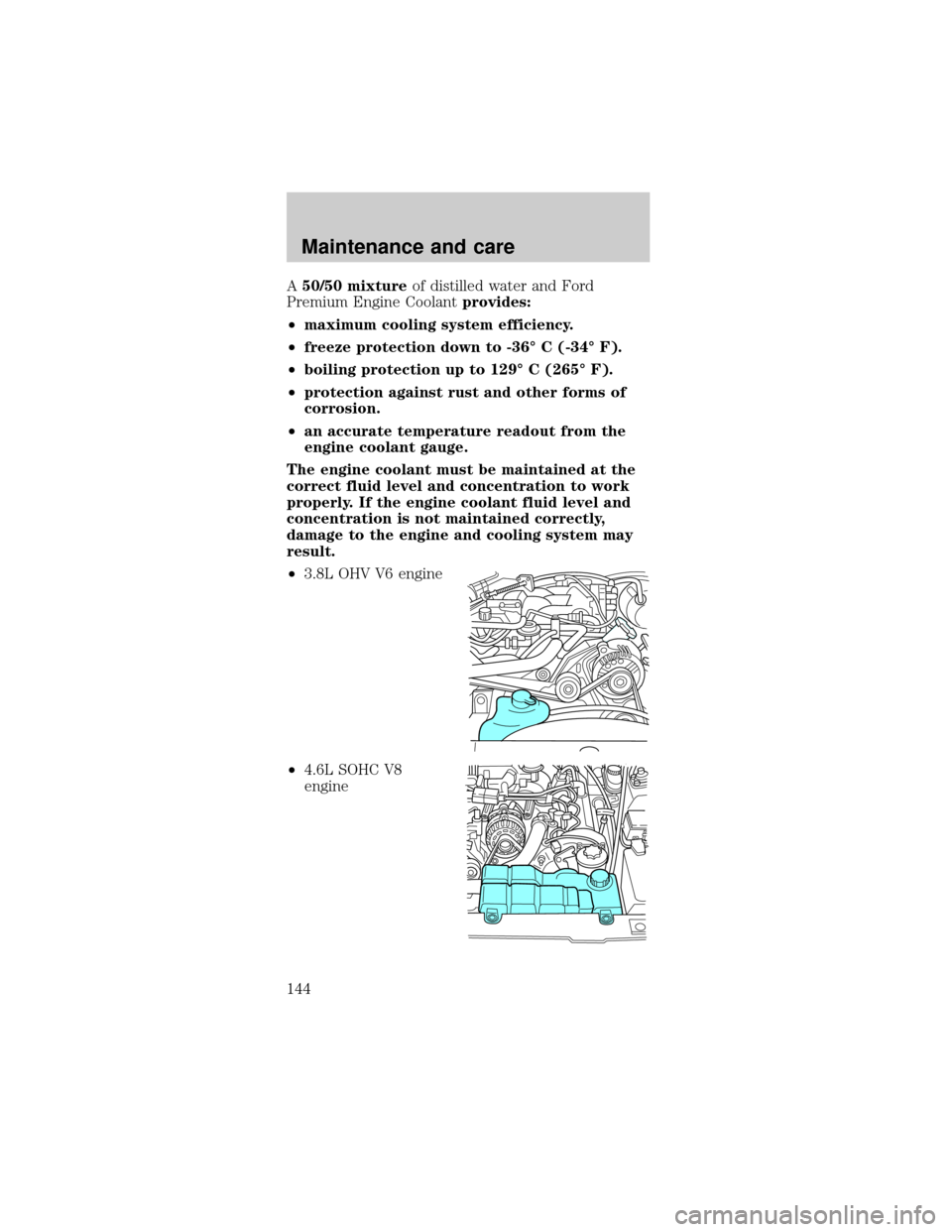
A50/50 mixtureof distilled water and Ford
Premium Engine Coolantprovides:
²maximum cooling system efficiency.
²freeze protection down to -36É C (-34É F).
²boiling protection up to 129É C (265É F).
²protection against rust and other forms of
corrosion.
²an accurate temperature readout from the
engine coolant gauge.
The engine coolant must be maintained at the
correct fluid level and concentration to work
properly. If the engine coolant fluid level and
concentration is not maintained correctly,
damage to the engine and cooling system may
result.
²3.8L OHV V6 engine
²4.6L SOHC V8
engine
Maintenance and care
144
Page 145 of 224
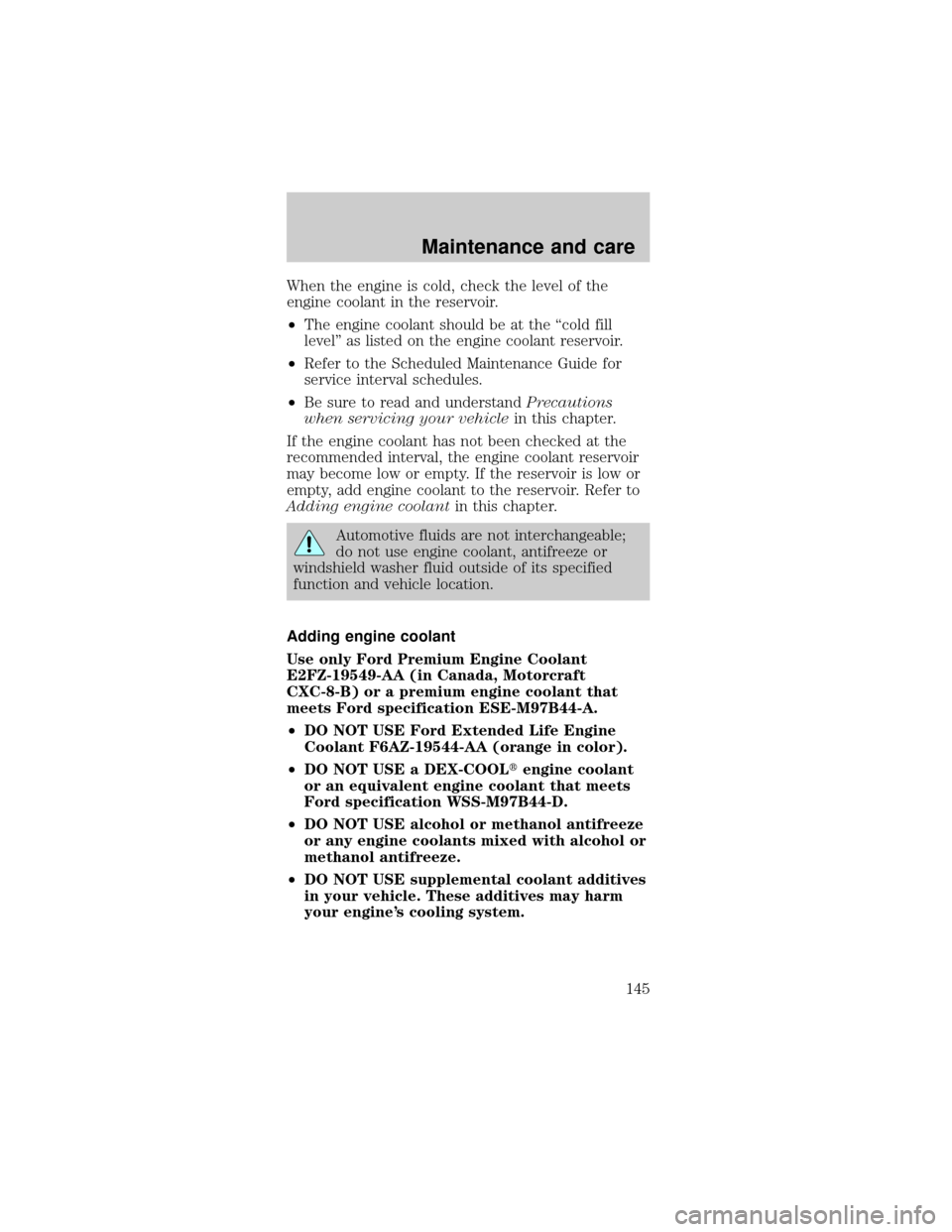
When the engine is cold, check the level of the
engine coolant in the reservoir.
²The engine coolant should be at the ªcold fill
levelº as listed on the engine coolant reservoir.
²Refer to the Scheduled Maintenance Guide for
service interval schedules.
²Be sure to read and understandPrecautions
when servicing your vehiclein this chapter.
If the engine coolant has not been checked at the
recommended interval, the engine coolant reservoir
may become low or empty. If the reservoir is low or
empty, add engine coolant to the reservoir. Refer to
Adding engine coolantin this chapter.
Automotive fluids are not interchangeable;
do not use engine coolant, antifreeze or
windshield washer fluid outside of its specified
function and vehicle location.
Adding engine coolant
Use only Ford Premium Engine Coolant
E2FZ-19549-AA (in Canada, Motorcraft
CXC-8-B) or a premium engine coolant that
meets Ford specification ESE-M97B44-A.
²DO NOT USE Ford Extended Life Engine
Coolant F6AZ-19544-AA (orange in color).
²DO NOT USE a DEX-COOLtengine coolant
or an equivalent engine coolant that meets
Ford specification WSS-M97B44-D.
²DO NOT USE alcohol or methanol antifreeze
or any engine coolants mixed with alcohol or
methanol antifreeze.
²DO NOT USE supplemental coolant additives
in your vehicle. These additives may harm
your engine's cooling system.
Maintenance and care
145
Page 146 of 224
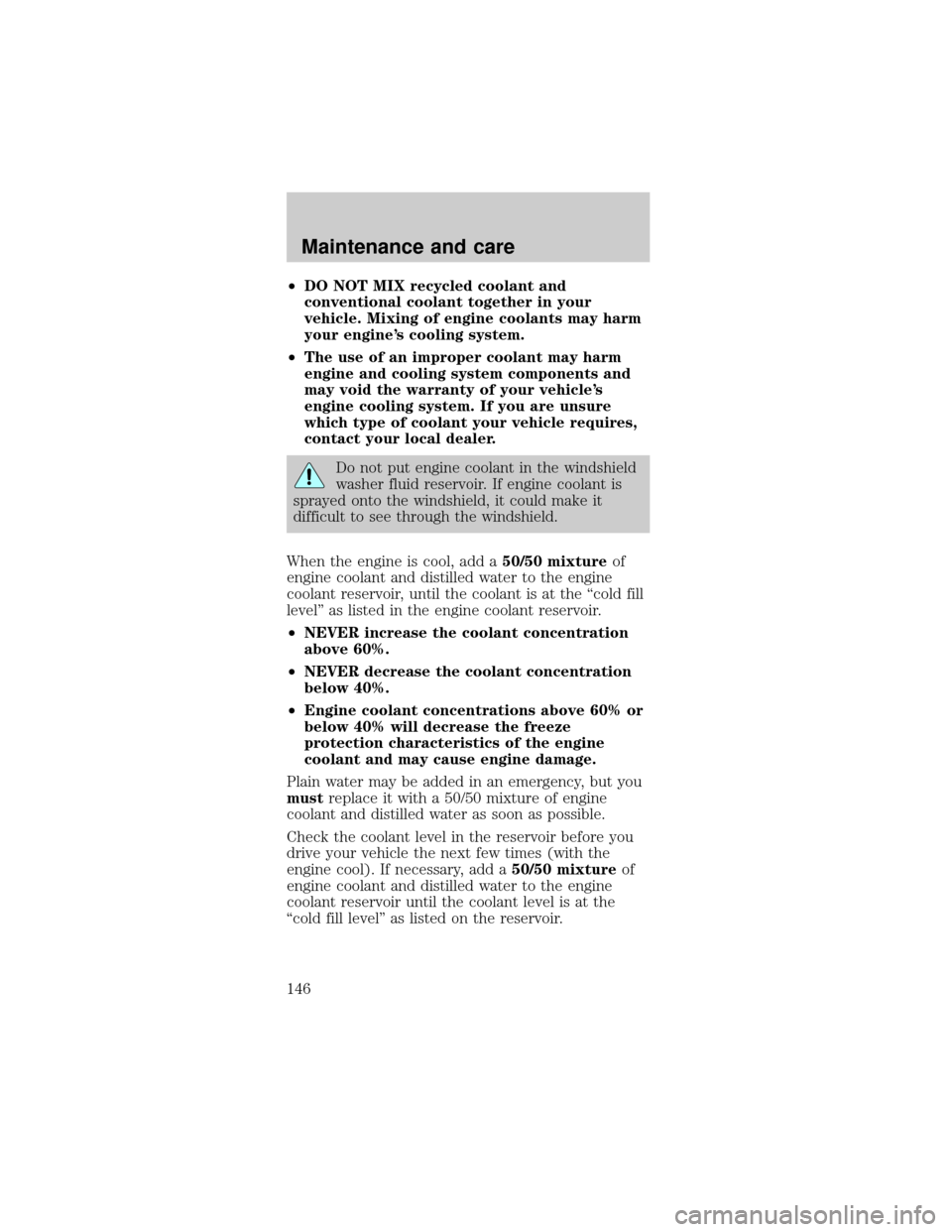
²DO NOT MIX recycled coolant and
conventional coolant together in your
vehicle. Mixing of engine coolants may harm
your engine's cooling system.
²The use of an improper coolant may harm
engine and cooling system components and
may void the warranty of your vehicle's
engine cooling system. If you are unsure
which type of coolant your vehicle requires,
contact your local dealer.
Do not put engine coolant in the windshield
washer fluid reservoir. If engine coolant is
sprayed onto the windshield, it could make it
difficult to see through the windshield.
When the engine is cool, add a50/50 mixtureof
engine coolant and distilled water to the engine
coolant reservoir, until the coolant is at the ªcold fill
levelº as listed in the engine coolant reservoir.
²NEVER increase the coolant concentration
above 60%.
²NEVER decrease the coolant concentration
below 40%.
²Engine coolant concentrations above 60% or
below 40% will decrease the freeze
protection characteristics of the engine
coolant and may cause engine damage.
Plain water may be added in an emergency, but you
mustreplace it with a 50/50 mixture of engine
coolant and distilled water as soon as possible.
Check the coolant level in the reservoir before you
drive your vehicle the next few times (with the
engine cool). If necessary, add a50/50 mixtureof
engine coolant and distilled water to the engine
coolant reservoir until the coolant level is at the
ªcold fill levelº as listed on the reservoir.
Maintenance and care
146
Page 147 of 224
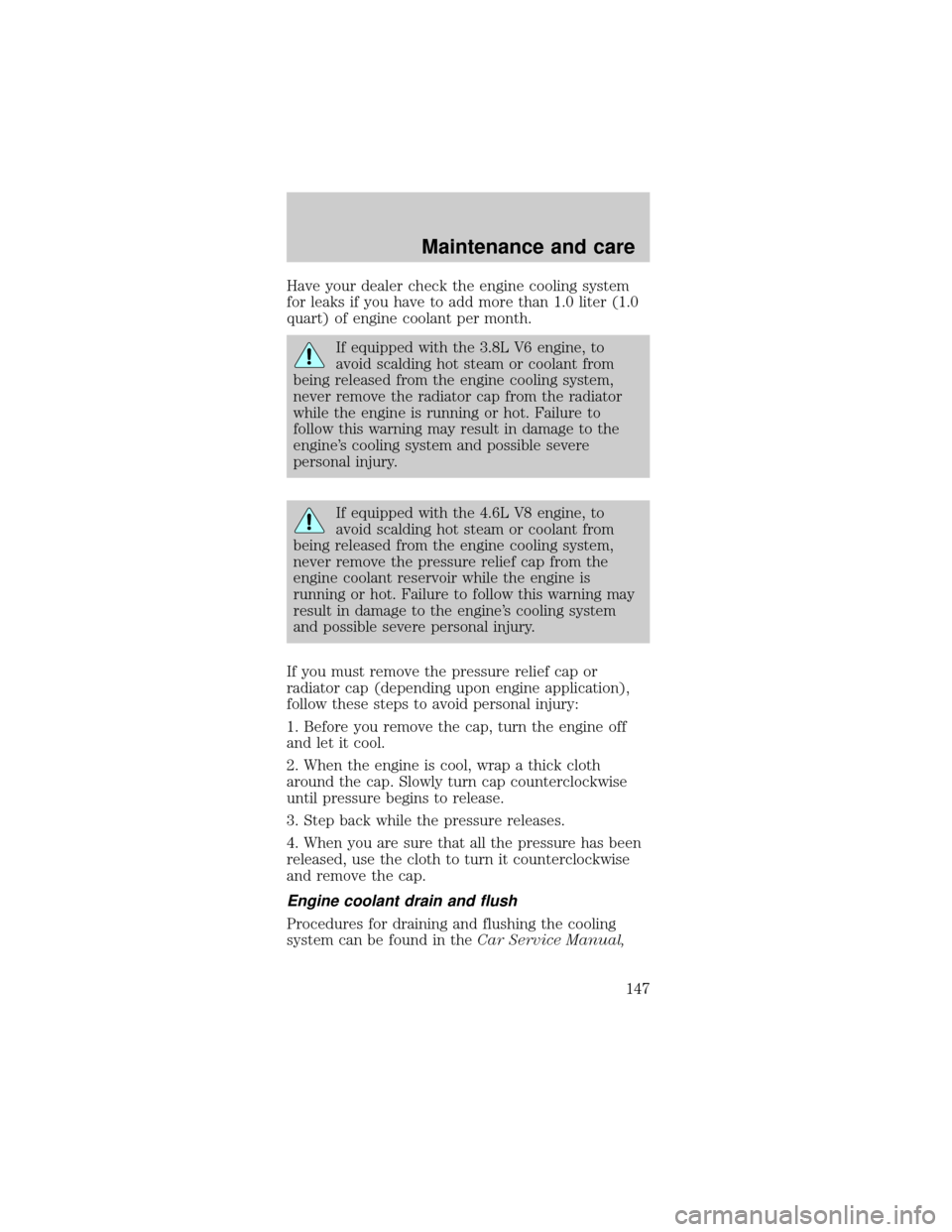
Have your dealer check the engine cooling system
for leaks if you have to add more than 1.0 liter (1.0
quart) of engine coolant per month.
If equipped with the 3.8L V6 engine, to
avoid scalding hot steam or coolant from
being released from the engine cooling system,
never remove the radiator cap from the radiator
while the engine is running or hot. Failure to
follow this warning may result in damage to the
engine's cooling system and possible severe
personal injury.
If equipped with the 4.6L V8 engine, to
avoid scalding hot steam or coolant from
being released from the engine cooling system,
never remove the pressure relief cap from the
engine coolant reservoir while the engine is
running or hot. Failure to follow this warning may
result in damage to the engine's cooling system
and possible severe personal injury.
If you must remove the pressure relief cap or
radiator cap (depending upon engine application),
follow these steps to avoid personal injury:
1. Before you remove the cap, turn the engine off
and let it cool.
2. When the engine is cool, wrap a thick cloth
around the cap. Slowly turn cap counterclockwise
until pressure begins to release.
3. Step back while the pressure releases.
4. When you are sure that all the pressure has been
released, use the cloth to turn it counterclockwise
and remove the cap.
Engine coolant drain and flush
Procedures for draining and flushing the cooling
system can be found in theCar Service Manual,
Maintenance and care
147
Page 148 of 224
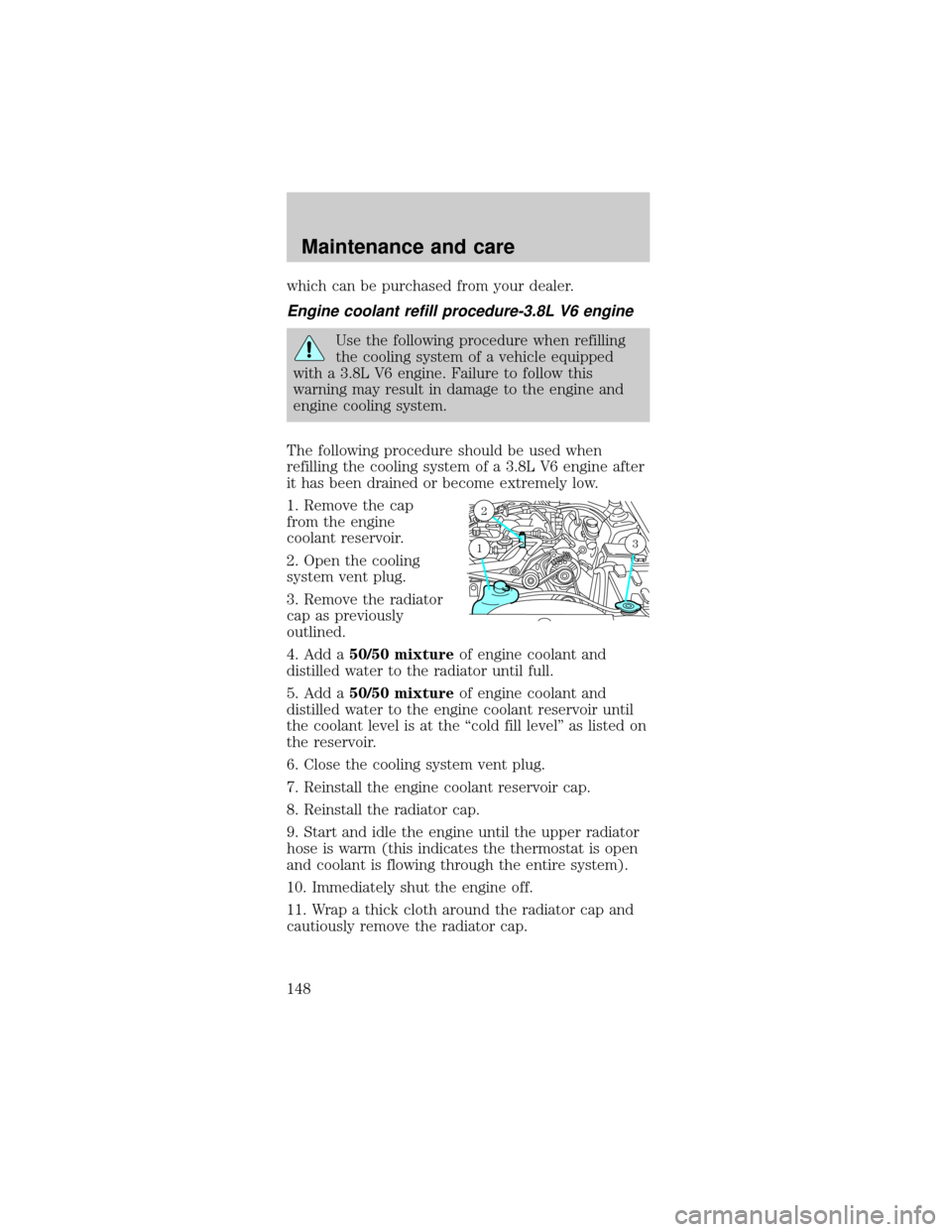
which can be purchased from your dealer.
Engine coolant refill procedure-3.8L V6 engine
Use the following procedure when refilling
the cooling system of a vehicle equipped
with a 3.8L V6 engine. Failure to follow this
warning may result in damage to the engine and
engine cooling system.
The following procedure should be used when
refilling the cooling system of a 3.8L V6 engine after
it has been drained or become extremely low.
1. Remove the cap
from the engine
coolant reservoir.
2. Open the cooling
system vent plug.
3. Remove the radiator
cap as previously
outlined.
4. Add a50/50 mixtureof engine coolant and
distilled water to the radiator until full.
5. Add a50/50 mixtureof engine coolant and
distilled water to the engine coolant reservoir until
the coolant level is at the ªcold fill levelº as listed on
the reservoir.
6. Close the cooling system vent plug.
7. Reinstall the engine coolant reservoir cap.
8. Reinstall the radiator cap.
9. Start and idle the engine until the upper radiator
hose is warm (this indicates the thermostat is open
and coolant is flowing through the entire system).
10. Immediately shut the engine off.
11. Wrap a thick cloth around the radiator cap and
cautiously remove the radiator cap.
2
31
Maintenance and care
148
Page 149 of 224

12. Add a50/50 mixtureof engine coolant and
distilled water to the radiator until full.
13. Reinstall the radiator cap.
14. Check the coolant level in the reservoir before
you drive your vehicle the next few times (with the
engine cool).
15. If necessary, add a50/50 mixtureof engine
coolant and distilled water to the engine coolant
reservoir until the coolant level is at the ªcold fill
levelº as listed on the reservoir.
If you are unsure of how to operate the cooling
system vent plug when adding engine coolant to the
3.8L V6 engine, contact your dealer.
Engine coolant refill procedure-4.6L V8 engine
The following procedure should be used when
refilling the cooling system of a 4.6L V8 engine after
it has been drained or become extremely low.
1. Remove the pressure relief cap from the engine
coolant reservoir as previously outlined.
2. Slowly add a50/50 mixtureof engine coolant
and distilled water to the engine coolant reservoir
until the coolant level is at the ªcold fill levelº as
listed on the reservoir.
3. Reinstall the pressure relief cap.
4. Start and idle the engine until the upper radiator
hose is warm (this indicates the thermostat is open
and coolant is flowing through the entire system).
5. Shut the engine off and let it cool.
6. Remove the pressure relief cap from the engine
coolant reservoir as previously outlined.
7. Add a50/50 mixtureof engine coolant and
distilled water to the engine coolant reservoir until
the coolant level is at the ªcold fill levelº as listed on
the reservoir.
8. Reinstall the pressure relief cap.
Maintenance and care
149
Page 150 of 224
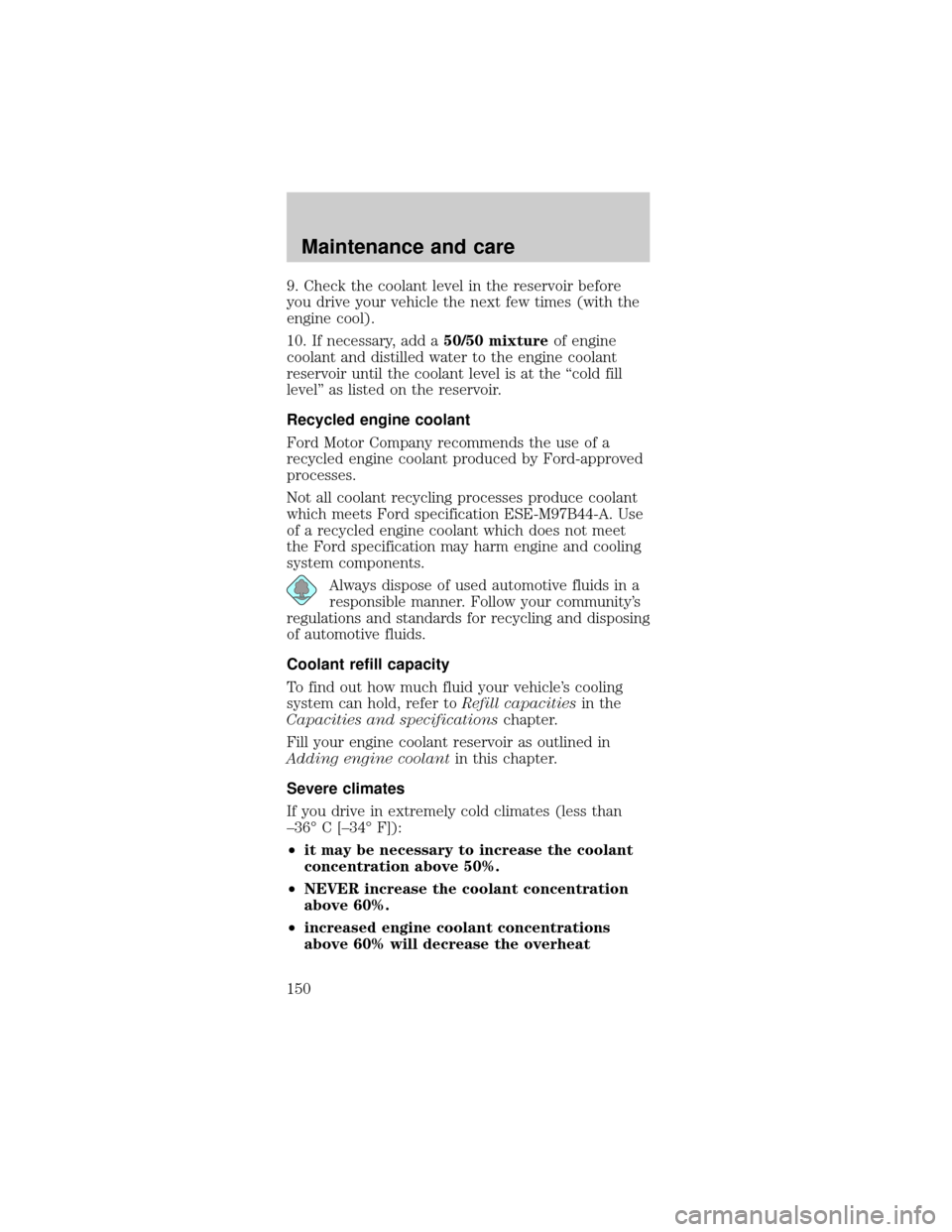
9. Check the coolant level in the reservoir before
you drive your vehicle the next few times (with the
engine cool).
10. If necessary, add a50/50 mixtureof engine
coolant and distilled water to the engine coolant
reservoir until the coolant level is at the ªcold fill
levelº as listed on the reservoir.
Recycled engine coolant
Ford Motor Company recommends the use of a
recycled engine coolant produced by Ford-approved
processes.
Not all coolant recycling processes produce coolant
which meets Ford specification ESE-M97B44-A. Use
of a recycled engine coolant which does not meet
the Ford specification may harm engine and cooling
system components.
Always dispose of used automotive fluids in a
responsible manner. Follow your community's
regulations and standards for recycling and disposing
of automotive fluids.
Coolant refill capacity
To find out how much fluid your vehicle's cooling
system can hold, refer toRefill capacitiesin the
Capacities and specificationschapter.
Fill your engine coolant reservoir as outlined in
Adding engine coolantin this chapter.
Severe climates
If you drive in extremely cold climates (less than
±36É C [±34É F]):
²it may be necessary to increase the coolant
concentration above 50%.
²NEVER increase the coolant concentration
above 60%.
²increased engine coolant concentrations
above 60% will decrease the overheat
Maintenance and care
150